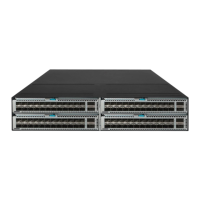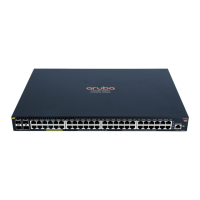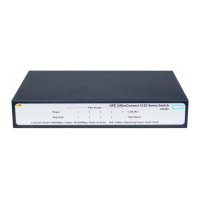67
[DeviceE-Ten-GigabitEthernet1/0/2] port link-type trunk
[DeviceE-Ten-GigabitEthernet1/0/2] port trunk permit vlan 1 to 30
[DeviceE-Ten-GigabitEthernet1/0/2] quit
# Create RRPP domain 1.
[DeviceE] rrpp domain 1
# Configure VLAN 4092 as the primary control VLAN of RRPP domain 1.
[DeviceE-rrpp-domain1] control-vlan 4092
# Configure the VLANs mapped to MSTI 1 as the protected VLANs of RRPP domain 1.
[DeviceE-rrpp-domain1] protected-vlan reference-instance 1
# Configure Device E as the master node of subring 2, with Ten-GigabitEthernet 1/0/1 as the
primary port and Ten-GigabitEthernet 1/0/2 as the secondary port. Enable ring 2.
[DeviceE-rrpp-domain1] ring 2 node-mode master primary-port ten-gigabitethernet
1/0/1 secondary-port ten-gigabitethernet 1/0/2 level 1
[DeviceE-rrpp-domain1] ring 2 enable
[DeviceE-rrpp-domain1] quit
# Enable RRPP.
[DeviceE] rrpp enable
Verifying the configuration
# Use the display commands to view RRPP configuration and operational information on each
device.
Dual-homed rings configuration example
Network requirements
As shown in Figure 21:
• Device A through Device H form RRPP domain 1. Specify the primary control VLAN of RRPP
domain 1 as VLAN 4092. Specify the protected VLANs of RRPP domain 1 as VLANs 1 through
30.
• Device A through Device D form primary ring 1. Device A, Device B, and Device E form subring
2. Device A, Device B, and Device F form subring 3. Device C, Device D, and Device G form
subring 4. Device C, Device D, and Device H form subring 5.
• Specify Device A, Device E, Device F, Device G, and Device H as the master nodes of Ring 1,
Ring 2, Ring 3, Ring 4, and Ring 5, respectively. Specify Ten-GigabitEthernet 1/0/1 as the
primary port and Ten-GigabitEthernet 1/0/2 as the secondary port on the rings.
• Specify Device A as the edge node of the connected subrings, its Ten-GigabitEthernet 1/0/3
and Ten-GigabitEthernet 1/0/4 as the edge ports. Specify Device D as the transit node of the
primary ring and edge node of the connected subrings, its Ten-GigabitEthernet 1/0/3 and
Ten-GigabitEthernet 1/0/4 as the edge ports. Specify Device B and Device C as the transit node
of the primary ring and assistant edge nodes of the connected subrings, their
Ten-GigabitEthernet 1/0/3 and Ten-GigabitEthernet 1/0/4 as the edge ports.
IMPORTANT:
Configure the primary and secondary ports on the master nodes correctly to make sure other
protocols still operate correctly when data VLANs are denied by the secondary ports.

